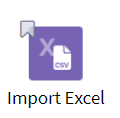Import Excel
This operator imports an Excel workbook sheet (or a specified portion of the sheet) from the Chorus workspace as a database table. The operator uses TIBCO® Data Virtualization to infer the schema of the imported database table.

Information at a Glance
|
Parameter |
Description |
|---|---|
| Category | Load Data |
| Data source type | TIBCO® Data Virtualization |
| Send output to other operators | Yes |
| Data processing tool | TIBCO® DV, Apache Spark 3.2 or later |
The Excel file from the workspace is read into memory. The data specified by the Sheet Number, Top Left Corner Cell, Right Cut-Off Column Letter, and Bottom Cut-Off Row Number parameters are extracted. If the Has Header Row parameter is set to No, then the operator prepends a row of column names with the Col prefix to the extracted data set. Then, the data is uploaded to TIBCO Data Virtualization in batches of 1,000 records. The TIBCO Data Virtualization infers the schema of a result database table based on the data values of each column. The resulting schema is then passed on to the downstream operators.
Input
The Import Excel operator is a source operator. Hence, there is no input data port.
Restrictions
The Excel files are read on the TIBCO Data Science - Team Studio server. Depending on the memory available on your instance, loading very large Excel files on this server might require a large amount of memory and can cause out-of-memory issues. For more information, see the Apache POI limitations.
Configuration
The following table provides the configuration details for the Import Excel operator.
| Parameter | Description |
|---|---|
| Notes | Notes or helpful information about this operator's parameter settings. When you enter content in the Notes field, a yellow asterisk appears on the operator. |
| Excel Workbook | Select the Excel workbook stored in the current workspace. Only workbooks with the .xls, .xlsx, and .xlsm extensions can be selected. For more information on uploading an Excel file to the workspace, see Creating a Work File. |
| Sheet Number | Specify the sheet number from the Excel workbook to extract (the first sheet is 1). Default: 1 |
| Top Left Corner Cell | Specify the cell address that defines the top-left cell of the data portion to extract in the selected sheet (for example, B10). |
| Right Cut-Off Column Letter | Specify the column letter where the portion of data to extract should be cut at the right. If not specified, the data extraction is cut at the last defined cell of the first row selected (the row number in the Top Left Corner Cell). This parameter is optional. |
| Bottom Cut-Off Row Number (0=not specified) |
Specify the row number where the portion of data to extract should be cut at the bottom. If this is set to 0, the data extraction is cut at the last defined row in the sheet. This parameter is optional. Note: It is the row number indicated in the Excel worksheet and not the actual number of rows to be extracted.
For example, if the Top Left Corner Cell is A1 and Has Header Row is Yes, then the number of rows to be extracted is the Bottom Cut-Off Row Number - 1. |
| Has Header Row | Specify whether the first row is treated as a header and each cell value of the row is used as the column name of the result table. If this is set to No, column names are set to Col1, Col2, Col3, and so on. |
| Output Schema | Specify the schema for the output table or view. |
| Output Table | Specify the table path and name where the output of the results is generated. By default, this is a unique table name based on your user ID, workflow ID, and operator. |
| Store Results | When set to Yes, the operator saves the results. If set to No, the operator does not save the results. |
Output
Example
The following example demonstrates the Import Excel operator.

-
Excel Workbook: raw_materials.xlsx
Note: The raw_materials.xlsx file is available in the current workspace. -
Sheet Number: 1
-
Top Left Corner Cell: A1
-
Bottom Cut-Off Row Number: 0
-
Has Header Row: Yes
-
Store Results: Yes
The following figure displays the output for the parameter settings for the Import Excel operator.
